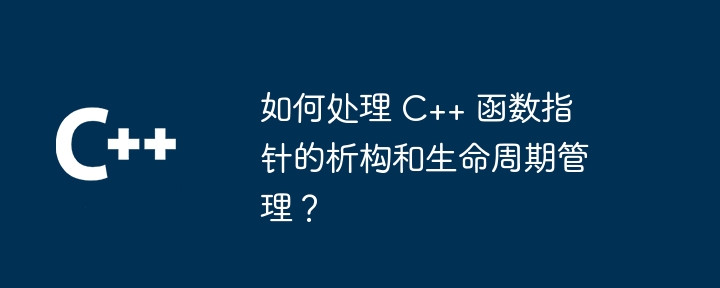Home >Backend Development >C++ >How to deal with destruction and life cycle management of C++ function pointers?
How to deal with destruction and life cycle management of C++ function pointers?
- PHPzOriginal
- 2024-04-17 17:48:011507browse
In C, function pointers require proper destruction and life cycle management. This can be achieved by manually destructing the function pointer and releasing the memory. Use smart pointers, such as std::unique_ptr or std::shared_ptr, to automatically manage the lifetime of function pointers. Bind the function pointer to the object, and the object life cycle manages the destruction of the function pointer. In GUI programming, using smart pointers or binding to objects ensures that callback functions are destructed at the appropriate time, avoiding memory leaks and inconsistencies.

How to deal with the destruction and life cycle management of C function pointers
In C, a function pointer is a pointer to a function pointer. Similar to ordinary pointers, function pointers also require proper destruction and life cycle management.
1. Manual destruction
The simplest method of destruction is to use the delete operator. For example:
void myFunction() { /* ... */ }
int main() {
void (*fptr)() = myFunction;
delete fptr; // 手动调用析构器
return 0;
}2. Smart pointer
In order to simplify the destruction, you can use smart pointers. Smart pointers automatically manage the life cycle of the objects they point to and provide exception safety. Commonly used smart pointers are:
-
std::unique_ptrcacfa7baab60b4d7be9d696125ea8fe3: A smart pointer that points to a uniquely owned object,
Deleteris a release function Type (for example,std::function47480109fa0edfb483b7be9db2b5a44c(const T&)). - std::shared_ptr8742468051c85b06f0a0af9e3e506b5c: Smart pointer to a shared ownership object, releasing the object when the last shared_ptr is destroyed.
For example:
#include <memory>
void myFunction() { /* ... */ }
int main() {
std::unique_ptr<void(*)()> fptr(myFunction); // std::function 适配器
// 对象 myFunction 析构将在 fptr 销毁时自动调用
return 0;
}3. Binding to an object
Another method is to bind a function pointer to an object. The object's lifetime manages the destruction of function pointers, just like member functions. For example:
class FunctionPointerHolder {
public:
FunctionPointerHolder(void (*fptr)());
~FunctionPointerHolder();
private:
void (*fptr_)();
};
FunctionPointerHolder::FunctionPointerHolder(void (*fptr)()) {
fptr_ = fptr;
}
FunctionPointerHolder::~FunctionPointerHolder() {
delete fptr_;
}
int main() {
auto holder = FunctionPointerHolder(myFunction); // 自动析构函数指针
return 0;
}Practical case:
In GUI programming, it is usually necessary to create a function pointer for the callback function. Properly handling the destruction of function pointers avoids memory leaks and inconsistencies. You can use smart pointers or bind function pointers to objects to ensure that callback functions are destroyed at the appropriate time.
The above is the detailed content of How to deal with destruction and life cycle management of C++ function pointers?. For more information, please follow other related articles on the PHP Chinese website!

